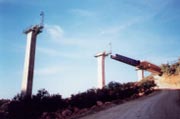Transport ministers back new EU core transport network (TEN-T)
22/03/2012

Transport ministers today reached agreement on proposals to transform the existing patchwork of roads, railways, airports and canals into a unified European transport network. The proposed Regulation for Guidelines for Trans-European Networks (TEN-T) will remove cross-border bottlenecks, upgrade infrastructure and streamline cross-border transport operations for passengers and businesses throughout the EU.
Commission Vice-President Siim Kallas, responsible for transport, said: "This is a very significant step forwards. Transport is the lifeblood of the European economy. And if it does not flow smoothly, our economy will weaken and fail to grow. Ministers have today given strong political backing for plans to build the strategic transport connections necessary to fuel Europe's future economic growth."
1. A new EU transport core network
Ministers backed proposals for a focused EU core transport network to be completed by 2030. Built using 10 major implementing transport corridors, this core network will establish the vital transport connections necessary to underpin the single market and fuel future economic growth. It allows a more focused and effective targeting of EU transport investments.
The core network will be complemented by a comprehensive transport network feeding into it, with a time horizon of 2050. This comprehensive network will ensure full coverage of the EU and accessibility of all regions. Both layers include all transport modes: road, rail, air, inland waterways and maritime transport, as well as intermodal platforms.
For links to the Council website, with maps agreed at the Transport Council see:
http://www.consilium.europa.eu/ueDocs/cms_Data/docs/pressData/en/trans/129080.pdf ![]()
http://www.consilium.europa.eu/press/council-meetings
2. High technical standards on the core network
The Commission's proposals set common technical requirements for the TEN-T infrastructure – with stronger requirements for the transport core network. This is to ensure seamless transport connections interoperability throughout the network.
It is clear that, in particular, for the core network, technical requirements must be interoperable across the network. For example, ERTMS (the European Rail Traffic Management System) – the basic ITS systems to control the trains must apply on most parts of the TEN-T network. Equally, road safety standards in terms of tunnel safety requirements and road safety requirements must apply across the network, and the technology for ITS (intelligent transport systems) must join up. Also if there are future electric vehicle infrastructure charging points to be built, logically, they must meet common standards, so the cars can use them all across the network.
3. 10 major transport corridors
A major innovation on the new TEN-T guidelines for is the introduction of 10 implementing corridors on the core transport network. This is necessary to ensure co-ordinated development of the network. The corridors will bring together the Member States concerned, as well as the relevant stakeholders, for example infrastructure managers and users. European co-ordinators will chair "corridor platforms" that will bring together all the stakeholders – these will be a major instrument to guarantee co-ordination, co-operation and transparency.
Background
The Commission's TEN-T proposals define the maps, technical requirements and target deadlines for the completion of the comprehensive and core network.
Under the new proposals, the new core European transport network will connect: by 2030:
-
86 main European ports with rail and road links
-
37 key airports with rail connections into major cities
-
15,000 km of railway line upgraded to high speed
-
35 major cross-border projects to reduce bottlenecks
See http://ec.europa.eu/transport/index_en.htm for the Commission's proposals for core network maps, national maps, project lists.
The TEN-T guidelines are an important element of the infrastructure package put forward by the Commission in October 2011, which also included the Connecting Europe Facility and the project bonds initiative.
What happens next?
The agreement reached today is a first step in the legislative process. The proposed regulation must still be approved by MEPs in the European Parliament at first reading. A vote by the European Parliament is foreseen for early 2013. With strong political will, the final text could be adopted in the first half of 2013.
For more background information on the Commission's TEN-T proposals:
http://ec.europa.eu/transport/infrastructure/revision-t_en.htm
Contacts :
Helen Kearns(+32 2 298 76 38)
Dale Kidd(+32 2 295 74 61)
More info:
Transport ministers back new EU core transport network (TEN-T) [IP/12/301]


